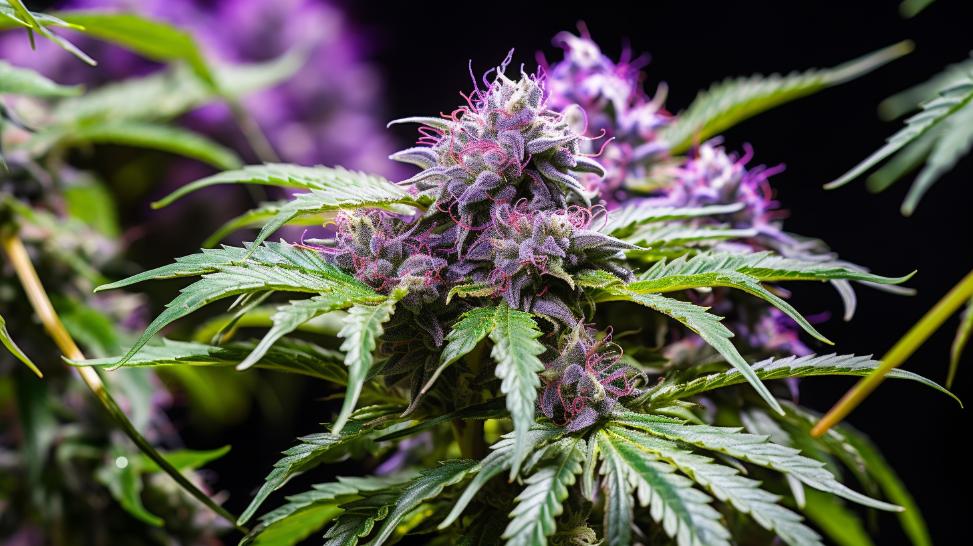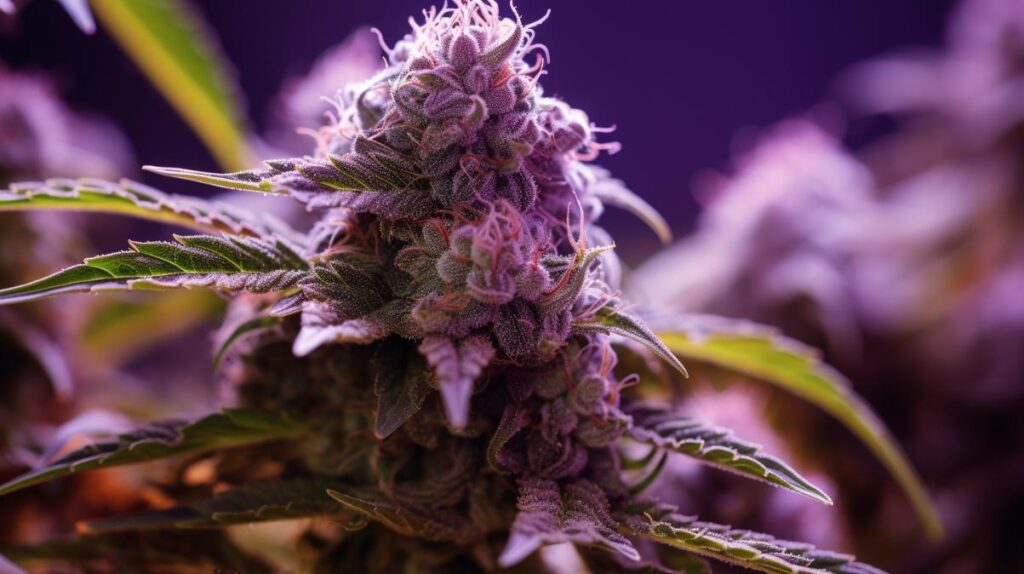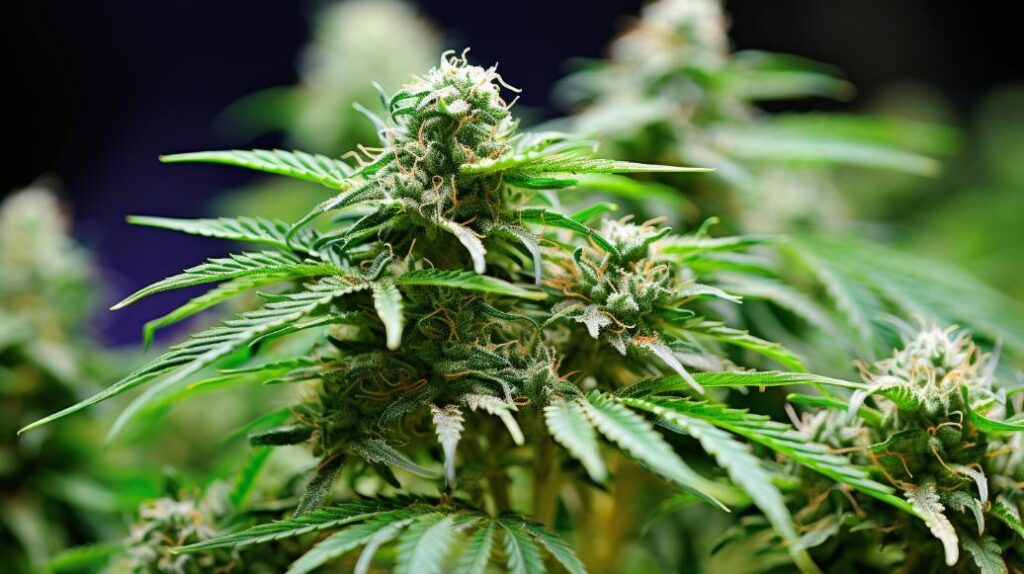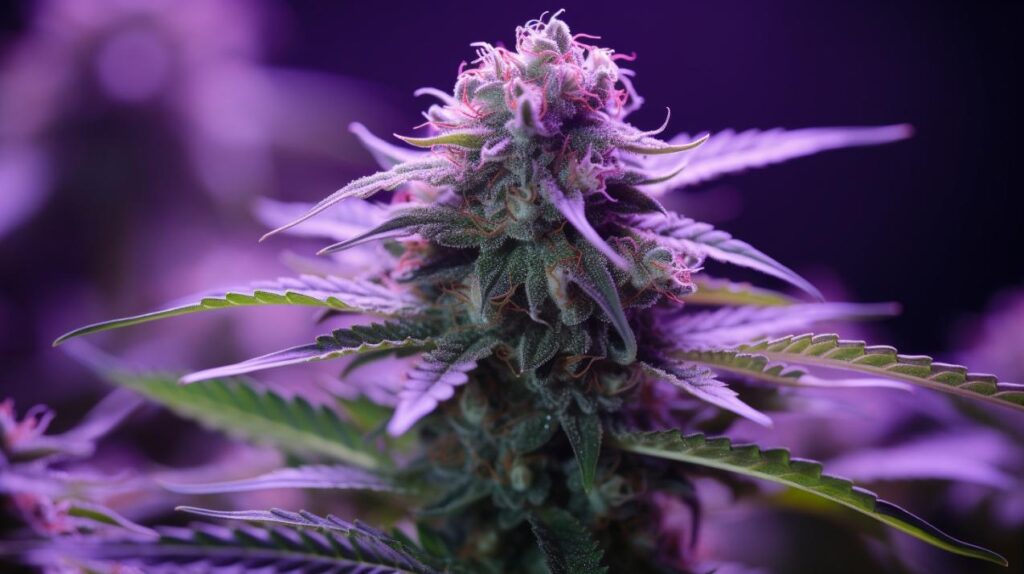Candyland

Candyland Strain, a sativa-dominant hybrid, is renowned for its stimulating and euphoric properties, which make it a favorite among cannabis enthusiasts seeking a cerebral high. Bred from the distinguished Granddaddy Purps and Platinum Cookies, Candyland boasts a pronounced sweet taste complemented by subtle earthy undertones, appealing to the palate with a complex flavor profile.
Typically, THC levels in this strain range from 18% to 24%, contributing to its potent effects. While its primary application lies in recreational use, many users report benefits in managing stress, anxiety, and fatigue, making it a versatile choice for both leisure and therapeutic purposes. Nonetheless, consumers are advised to consult with healthcare professionals when considering its use for medical conditions.
Genetic Lineage
The genetic lineage of the Candyland strain is a sophisticated amalgamation that includes a crossbreed of Granddaddy Purps and Platinum Cookies, contributing to its notable characteristics.
As a cannabis strain, Candyland stands out for its unique profile, a testament to the meticulous cultivation and hybridization expertise of Ken Estes.
This Sativa-leaning hybrid showcases a complex array of traits inherited from its parent strains—Granddaddy Purple, an indica known for its deep relaxation effects, and Bay Platinum Cookies, a hybrid with a reputation for its uplifting and cerebral high.
The resultant Candyland strain embodies a synergy of effects and aromas, underpinned by a rich genetic tapestry that resonates with both connoisseurs and cultivators in the cannabis community.
History and Origin
Originating from the fertile cannabis culture of Northern California, Candyland was conceived through the innovative breeding efforts of Ken Estes, a renowned figure in the marijuana industry. This sativa-dominant hybrid is a testament to meticulous genetic selection, combining the best attributes of its parent strains.
To understand the significance of Candyland’s emergence, consider the following facts:
-
Award-Winning Pedigree: Candyland clinched the first-place trophy for best Sativa at Denver’s 2012 KushCon, a testament to its superior quality and effects.
-
Therapeutic Versatility: With THC levels ranging between 18% to 24%, it provides a balance that caters to both recreational and medicinal users, distinguishing it from other strains with similar effects.
-
Geographic Popularity: Its acclaim is not restricted to its birthplace; it has notably spread to the West Coast, Colorado, and Michigan, reflecting its broad appeal.
This strain’s nuanced history and refined genetic profile underscore its esteemed position within the cannabis industry.
THC/CBD Content
Candyland strain boasts a THC concentration ranging from 18% to 24%, complemented by a CBD content near 1%, reflecting its strength and potential for a balanced cannabinoid experience. The variation in THC/CBD content suggests a degree of unpredictability, which may influence the cannabis experience. This variability underscores the importance of reliable lab testing to ensure consumers can anticipate the effects of the strain. A detailed understanding of the THC/CBD content assists users in making informed decisions about consumption and dosing.
| Compound | Minimum % | Maximum % |
|---|---|---|
| THC | 18 | 24 |
| CBD | Approximately 1 | Approximately 1 |
| Average THC (reported) | 14 | 19 |
The analytical approach to understanding Candyland’s cannabinoid profile is essential in evaluating its potential therapeutic and recreational effects, given its complex terpene synergy and genetic lineage.
Terpene Profile
Delving deeper into the Candyland strain’s characteristics, its diverse terpene profile significantly shapes the sensory experience and potential effects for users. The terpenes contribute more than just flavor and aroma; they may also influence the therapeutic qualities of the cannabis strain.
Here are key components of the Candyland terpene profile:
-
Beta Caryophyllene (0.43%): This terpene is known for its spicy and peppery notes, potentially offering anti-inflammatory properties.
-
Limonene (0.18%): Adding a bright, citrusy aroma, limonene is associated with mood elevation and stress relief.
-
Linalool (0.17%): Linalool provides a floral accent, which may have calming effects on the user.
These terpenes, along with others like alpha humulene, alpha pinene, beta myrcene, and terpinolene, synergistically create Candyland’s complex and therapeutic terpene profile.
Effects
The effects of the Candyland strain are predominantly cerebral, often manifesting as a burst of energy and an uplifted mood, accompanied by increased sociability. Anecdotal evidence suggests that individuals using cannabis, particularly the Candyland variety, report a marked improvement in their capacity for social interaction, describing a conversational ease that is both pleasurable and functional.
Many users claim that the strain’s invigorating properties make it ideal for daytime use, as it appears to enhance alertness without the sedative effects commonly associated with other cannabis strains. However, it is important to approach its use with caution, as some individuals have reported less desirable effects such as dry eyes, anxiety, and paranoia.
These responses highlight the necessity for personalized dosing and a careful assessment of one’s tolerance and reaction to the Candyland strain.
Medical Uses
Efficacy in symptom management positions the Candyland strain as a potentially therapeutic option for various medical conditions. Its medical uses are substantiated by patient reports and anecdotal evidence which highlight its versatility in the realm of cannabis for medical purposes.
Analyzing user feedback reveals key areas of impact:
-
Stress Alleviation: With a significant 31% of users experiencing relief, Candyland is utilized to counter stress-related symptoms, promoting relaxation and mental clarity.
-
Depression Mitigation: Approximately 30% of users find it beneficial for depression, where its uplifting properties may contribute to mood stabilization and enhanced emotional well-being.
-
Anxiety Reduction: The calming yet energizing effects of Candyland assist 24% of users in managing anxiety, potentially aiding in social functioning and overall daily activities.
These findings suggest that Candyland’s therapeutic potential warrants further clinical investigation.
Flavor and Aroma
Many users of the Candyland strain are immediately struck by its distinctive sweet and spicy aroma, which complements its reputation for symptom relief.
This particular scent profile owes its complexity to the strain’s esteemed lineage, as it is a cross between the flavorful Bay Platinum Cookies and the iconic Granddaddy Purple.
The spicy notes likely hark back to the musky undertones of Granddaddy Purple, while the sweet aspects are reminiscent of the dessert-like quality associated with Bay Platinum Cookies.
The combination yields an olfactory experience that is both nuanced and robust. Connoisseurs appreciate the depth of the earthy and herbal notes that emerge upon consumption, adding to Candyland’s allure as a strain with a potent and enjoyable flavor profile that is as intricate as it is delightful.
Appearance
Upon first glance, the Candyland strain stands out with its compact buds that are artfully speckled with gold flecks and blanketed in shimmering trichomes. This particular phenotype exhibits a striking visual appeal that draws in connoisseurs and casual users alike, often featured in dispensaries near regions where its popularity peaks.
Key visual characteristics include:
- Various shades of deep green leaves that provide a rich backdrop for the more vibrant elements.
- Dense buds indicative of high resin content, suggesting a potent experience for consumers.
- A camouflage-colored appearance that hints at the strain’s complex genetic lineage.
Experienced cultivators and those seeking quality cannabis products near them appreciate Candyland for its visual allure, which promises an equally complex flavor and aromatic profile.
Grow Information
The majority of Candyland cultivators note that this strain requires a moderate level of growing experience due to its specific light and nutrient needs. Detailed grow information indicates that achieving the optimal balance of these factors is crucial for Candyland to develop its characteristic dense buds and high resin content.
Indoor growers should meticulously manage light cycles to ensure flowering commences within the typical 8-9 week timeframe. Meanwhile, outdoor growers need to factor in regional climatic conditions, with Northern Hemisphere harvests ready by early October and Southern Hemisphere counterparts by early April.
The plant’s relatively thin sun leaves suggest an efficient light penetration, which supports a healthy flowering process. Utilizing precise nutrient regimens, growers can maximize resin production, a highly sought-after trait of the Candyland strain.
Adverse Effects
Consumption of the Candyland strain can lead to dehydration, manifesting as dry mouth and eyes, and in some cases, may induce anxiety or paranoia, particularly in novice users. While the euphoric and uplifting effects of this strain are often sought after, it is imperative for consumers to be aware of the potential adverse effects that can accompany its use. An analytical approach to understanding these effects underscores the importance of moderation and recognition of one’s own tolerance levels.
Key adverse effects include:
- Dehydration, leading to discomfort and a need for increased fluid intake.
- The possibility of heightened anxiety or paranoia, especially in those with a predisposition to these conditions.
- A dry mouth sensation, often referred to as ‘cottonmouth.’
It is advisable to consult with a health professional before using the Candyland strain to mitigate potential adverse effects and ensure a safe consumption experience.
Comparisons with Similar Strains
Considering the sweet and spicy flavor profile of Candyland, strains such as Granddaddy Purple and Green Crack offer similar taste experiences and are known for their uplifting effects that may also aid in stress and fatigue management.
Granddaddy Purple, an indica-dominant hybrid, shares a grape and berry aroma akin to Candyland’s sweetness, while Green Crack’s tangy, fruity flavor complements Candyland’s spicy notes. Both are reputed among consumers for their energizing influence, which can be beneficial to those seeking reprieve from mental strain.
However, when considering these alternatives, it is essential to consult with a medical professional for health advice, as individual reactions to cannabis strains can vary. This ensures a personalized approach to using such strains for therapeutic purposes, supporting health and wellbeing.
Research and Studies
Candyland’s therapeutic potential has been illuminated by research indicating its efficacy in managing stress, depression, and anxiety. As a medical professional delving into the strain’s properties, one must consider the empirical data:
-
Energetic Effects: Studies involving 1182 individuals highlight Candyland’s ability to induce a state of energy and upliftment.
-
Mood Regulation: The presence of Limonene and Linalool, as identified in lab analyses, supports the anecdotal evidence for its mood-stabilizing qualities.
-
Stress Reduction: Beta Caryophyllene, a prominent terpene in Candyland, is known for its stress-relieving properties, aligning with user-reported outcomes.
In-depth research and studies are paramount to validate these findings and further understand the strain’s potential within therapeutic contexts. The analytical scrutiny of its terpene and cannabinoid profile is essential for an experienced interpretation of its medical applicability.
Frequently Asked Questions
What Strain Is Candyland?
Addressing the inquiry about Candyland’s classification, it originates from a genetics puzzle that combines Granddaddy Purple with Platinum Cookies, resulting in a sativa-dominant hybrid known for its uplifting and therapeutic properties.
Is Candy Jam a Sativa or Indica Strain?
The Candy Jam strain’s genetics and flavor profile suggest a blend influenced by Sativa. Analyzing its characteristics, one would classify it as Sativa-dominant, assuming a similar energetic effect as its Candy genetics imply.
How Does Candyland Strain Make You Feel?
The subject in question typically induces mood elevation and may provide a creative boost, counteracting depressive states with its energizing properties, while potentially eliciting adverse reactions such as anxiety in sensitive individuals.
Is Candy Kush a Sativa or Indica?
Candy Kush exhibits a genetic blend that often leads to strain confusion; it is primarily an indica-dominant hybrid, contrasting the sativa-leaning lineage seen in other "Candy" genetics. Its effects are deeply relaxing and euphoric.







Responses